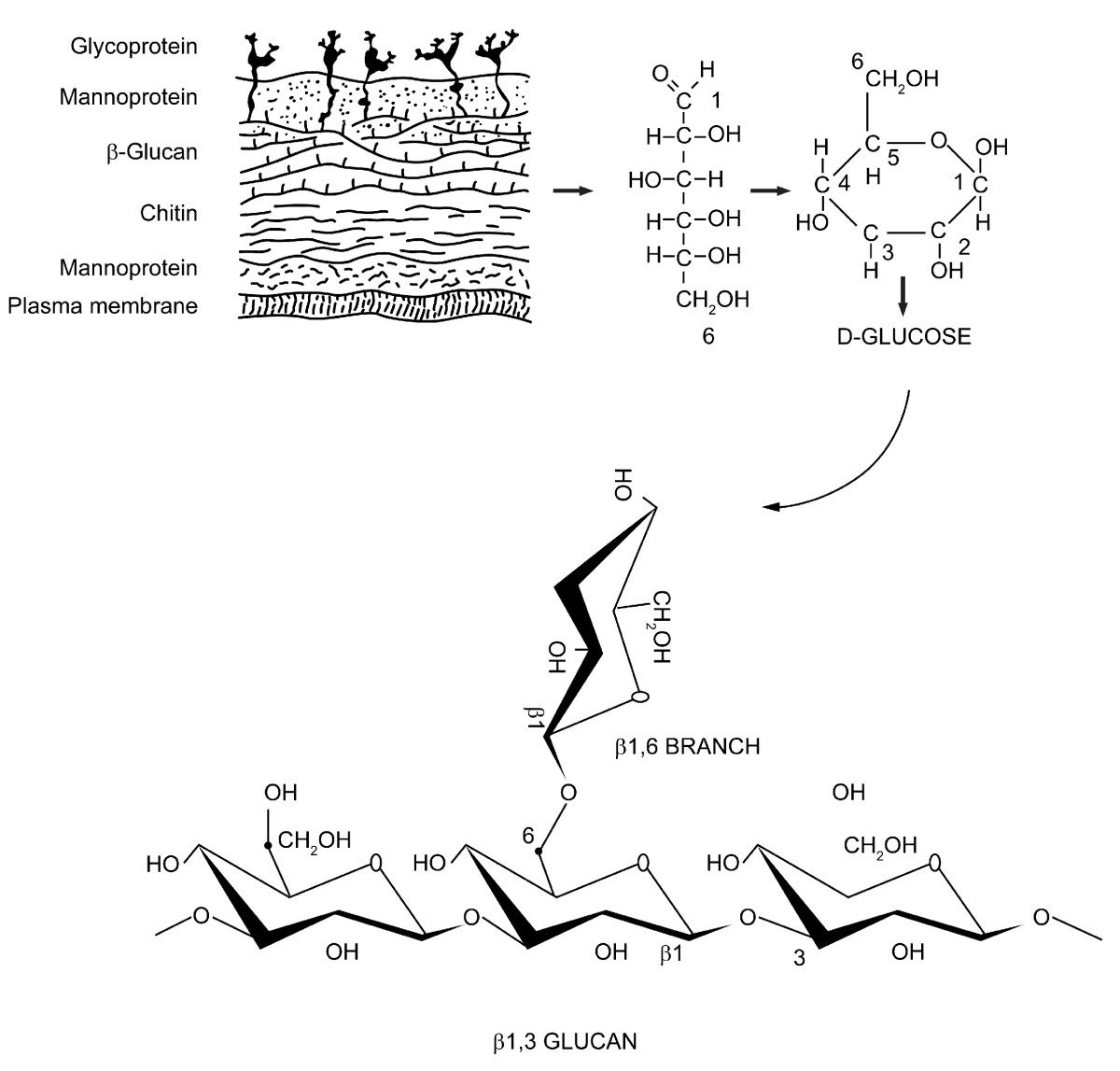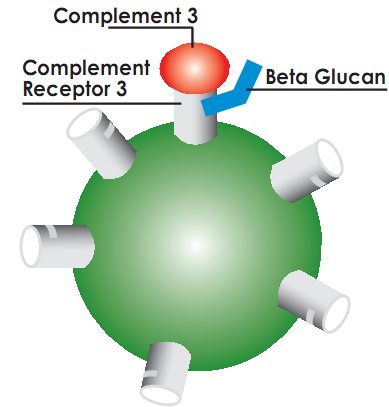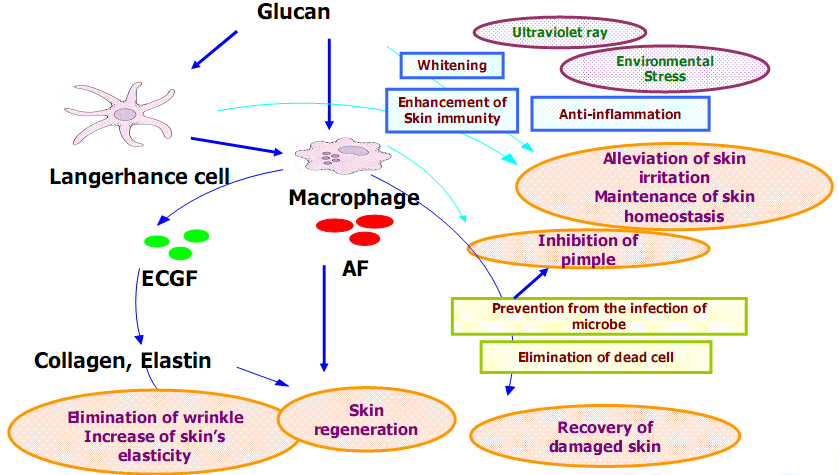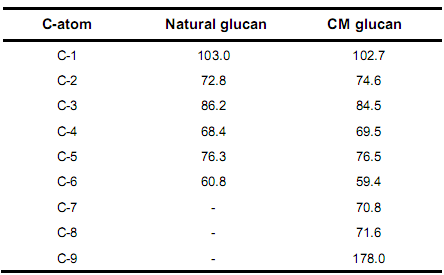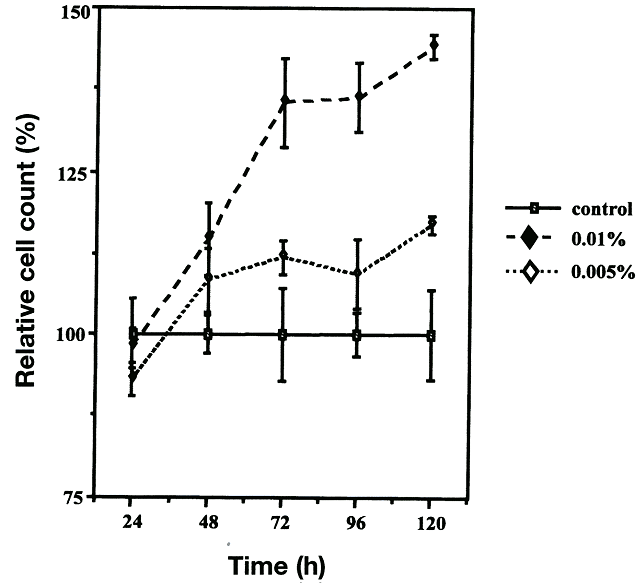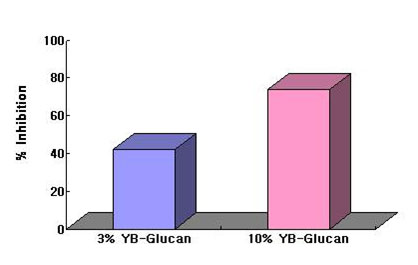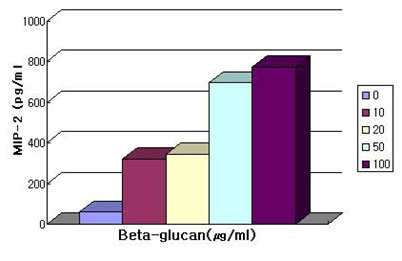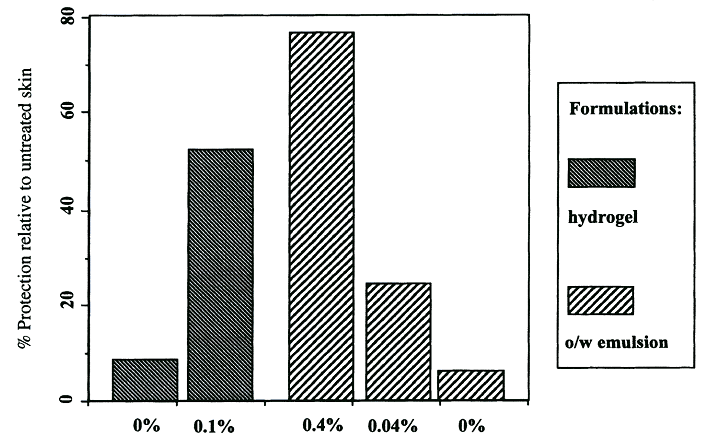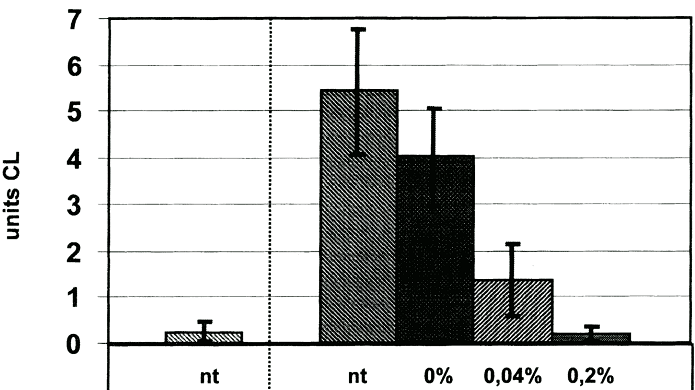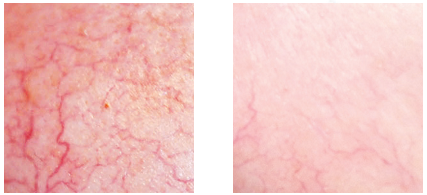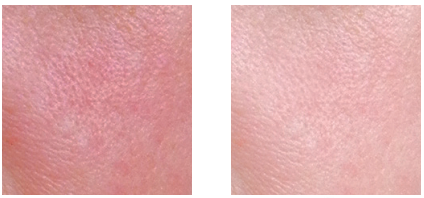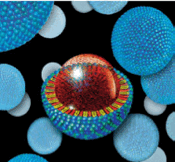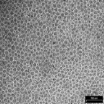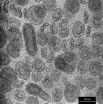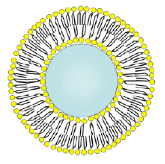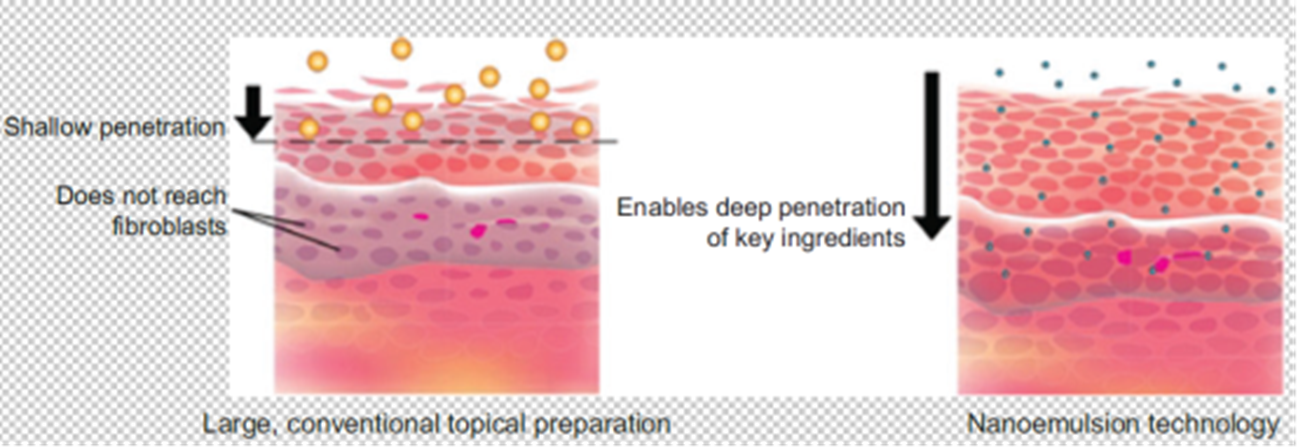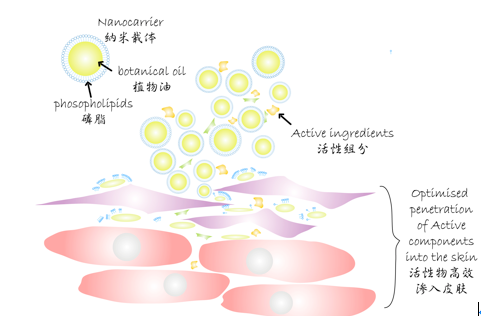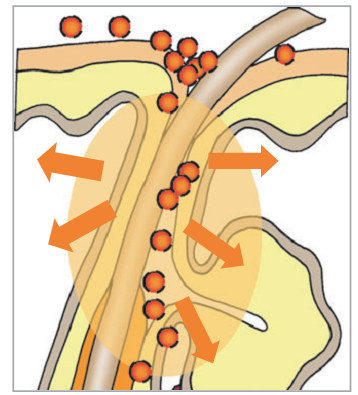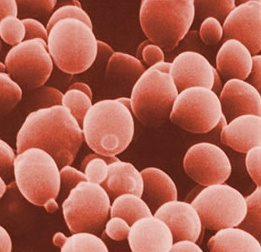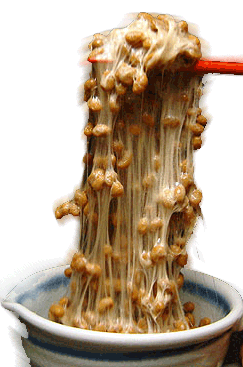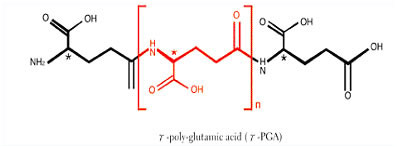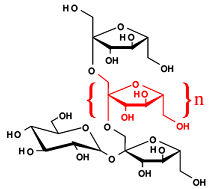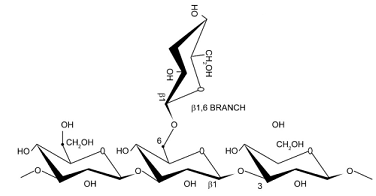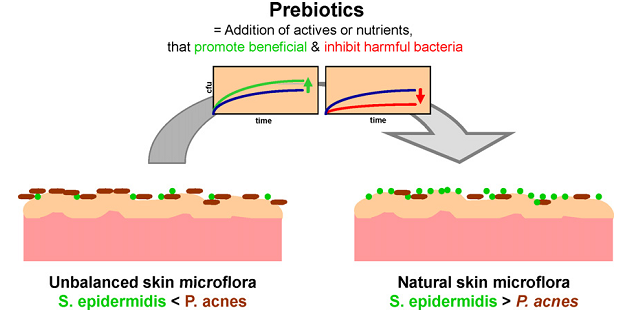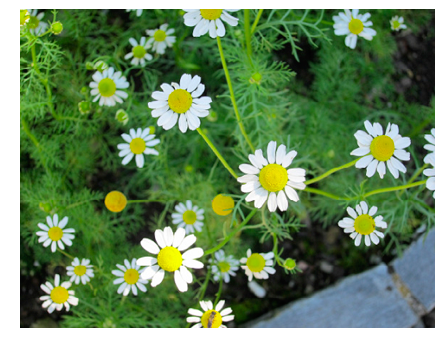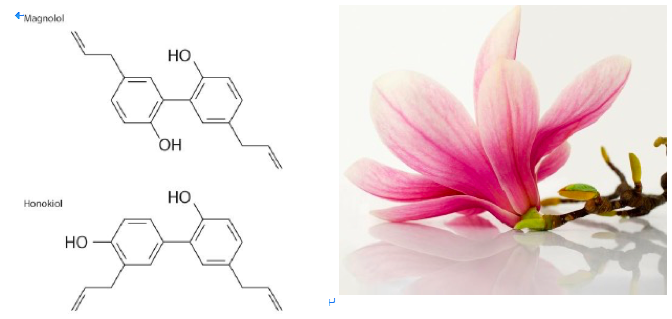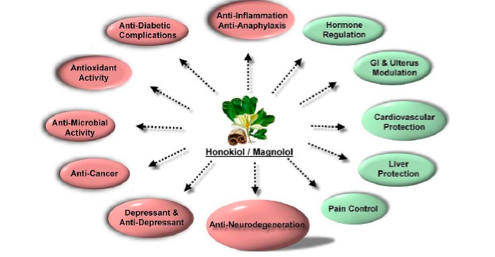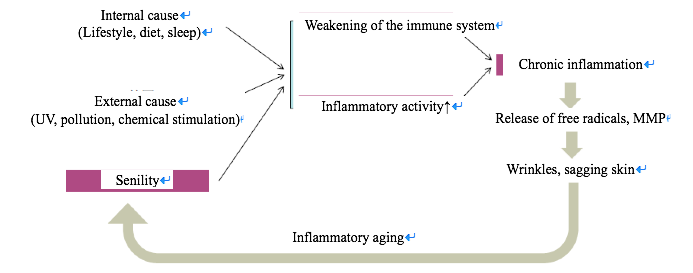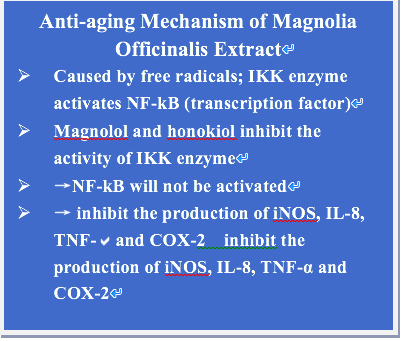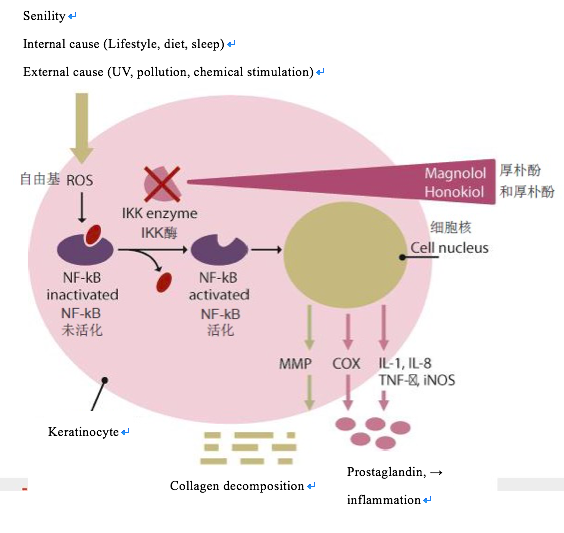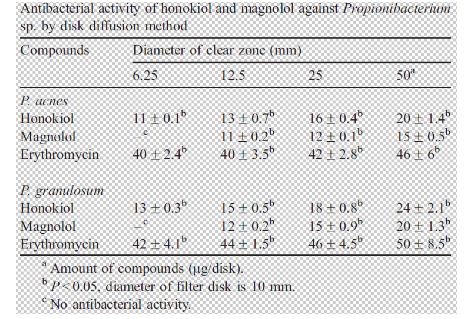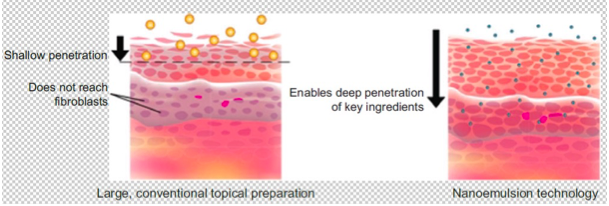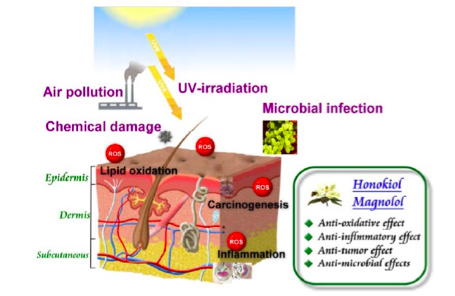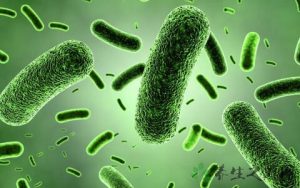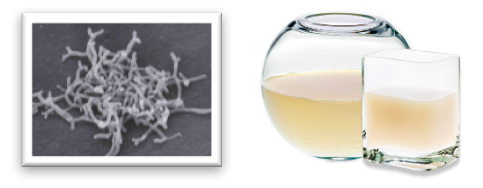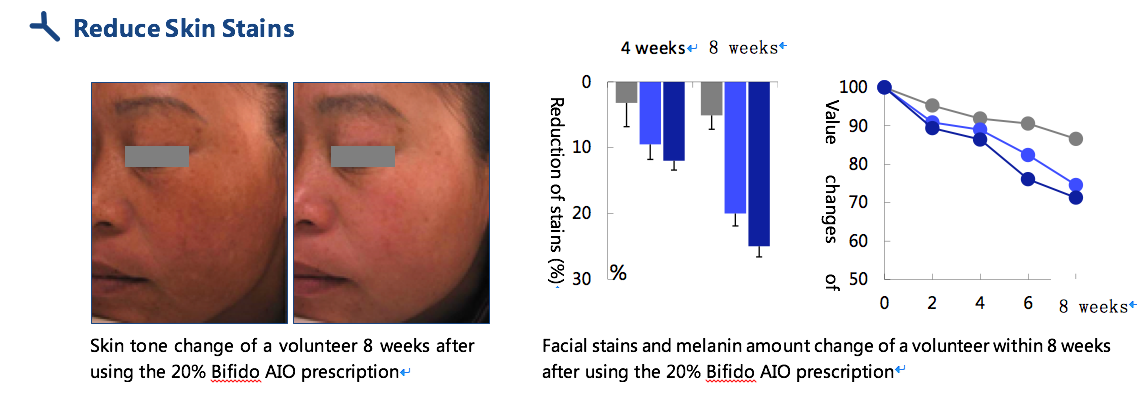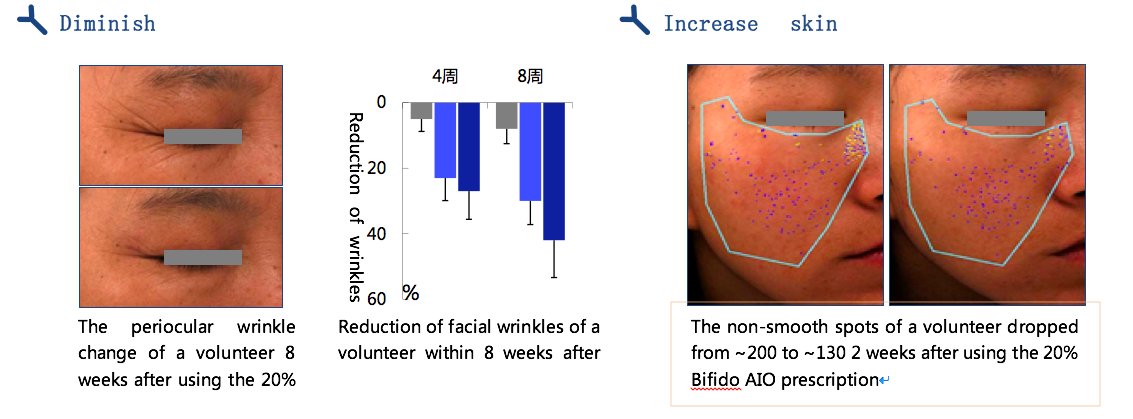A perfect match of biopharmaceutical technology and nanotechnology
Description: With the rise of skin microbiology, the combination of probiotics and prebiotics (i.e., Synbiotics) targeting the removal of bacteria harmful to skin with targets has been the latest trend in the materials of international skincare and skincare products. BioNanoCare is a nano-encapsulated synbiotic designed for the skin micro-ecological balance and skin repair, using modern biological and nano-technology, combined with probiotics and prebiotics, and targeting bacteria harmful to skin. With advantages of safety, high efficiency and environmental friendliness, it will not kill good bacteria together with bad ones like traditional antibiotics. The nano-encapsulated probiotics extract can provide nutrients and moisture for skin repair, thereby moisturizing, preventing aging and wrinkles and inhibiting pigmentation, so that the skin will return to normal. The nano-encapsulated prebiotics can effectively promote the proliferation of probiotics on the skin surface, thereby inhibiting the growth of harmful bacteria, restore the micro-ecological balance of skin as soon as possible, and keep the skin young. Specially added water-soluble yeast glucan can effectively activate skin Langerhans cells, and play a role in anti-inflammation, anti-allergy, eliminating the activity of radicals, moisturizing and accelerating the renewal of the stratum corneum, helping the skin resist external exogenous various mechanical and chemical stimuli and promoting the recovery of injuries.

Saccharomyces cerevisiae Fructo oligosaccharide Lactobacillus
Fungi, bacteria and viruses on the surface of human skin constitute a complex microbial ecosystem called the “skin microbiome”. Microbiome study is becoming popular in the biomedical field. In May 2016, the White House announced the launch of the National Microbiome Initiative (NMI), aiming to promote the development of microbial science, benefiting individuals, communities and all of humanity in the areas of health care, food production, environmental protection, etc. As a hot theme in biomedicine, microbiome is expanding into the field of skin research. The international renowned pharmaceutical company Johnson & Johnson also announced the establishment of the Johnson & Johnson Human Microbiome Research Center in February last year. In recent years, the company has endeavored a lot to develop the role of microbiome in the development of new drugs. It is reported by Happi that Johnson & Johnson Consumer Inc. has reached an agreement with Xycrobe Therapeutics, a US biotechnology startup, to further cooperate on the treatment of inflammatory skin diseases.
The research team led by the National Institute of Allergy and Infectious Diseases (NIAID) published an article in Nature(Jan 5, 2015), stating that the skin microbiome can significantly affect immunity. The researchers transplanted different types of symbiotic bacteria into mice to prompt them to produce specific immune cells of symbiotic bacteria. After the transplantation of S.epidermidis, a common skin symbiotic bacterium, onto the skin of mice, the number of CD8+T cells is increased, and this immune cell can produce the chemical messenger IL-17A. Studies have shown that Staphylococcus epidermidis can enhance immunity to specific pathogens without causing inflammation. Different types of skin symbiotic bacteria can cause different immune responses, which indicates that immune cells in skin can quickly sense and respond to changes in the skin flora. These findings help explain the protective role of skin symbiotic bacteria and to reveal the specific mechanisms of how flora changes cause skin diseases.

Human Skin Microbial Map
The paper “Temporal Stability of the Human Skin Microbiome” published in Cell(May 5, 2016) reported a new metagenomic study which shows that despite frequent cleaning and exposure to bacteria-rich objects, our individual skin microbial environment remains highly stable after a period of time. This recognition can be used to better understand a range of human skin diseases, thus helping to develop prebiotic, probiotic and microbial transplantation.
According to a survey of the World Health Organization (WHO), among the yellow races, people whose skin is in a healthy state account for less than 10%, more than 20% are in a morbid state, and 70% are in a sub-healthy state. The past 30 years has seen the significant growing trend of skin diseases in the world. The abuse of antibiotics and hormones has led to more and more skin diseases caused by the environment, e.g., eczema, acne, hormonal dermatitis, cosmetic-dependent dermatitis, seborrheic dermatitis, etc. With the development of biomedicine, the study found that 95% of skin diseases show a skin micro-ecological imbalance.
Micro-ecological balance refers to the dynamic balance of normal combination of normal micro-organisms and their host ecosystems during the long-term evolution process. On the surface of the normal person, i.e., on the surface of the skin and internal parts, there are numerous microorganisms. The floras on the skin surface is divided into resident and temporary ones, most of which are beneficial to our body, such as clearing the waste on the skin surface (apoptotic cells), decomposing excessive lipids, resisting the invasion of foreign pathogens through competitive inhibition, etc. When the balanced relationship is broken, the skin function will be disordered, which causes diseases. Therefore, the Human Microbiological Program funded by the National Institutes of Health has been implemented to explore the characteristics and role of human micro-ecology. Recently, researches on skin micro-ecology have also received increasing attention from dermatologists. The balance and stability of floras have an important impact on the physiological function of bodies. The balance and stability of the in vivo floras directly affects the barrier effect of the skin surface on the external defense, and can obviously promote the balance of floras and improve the immunity.
Billions of bacteria that inhabit human bodies form a tiny ecosystem, which is necessary for maintaining normal human growth. Guts, oral cavity, skin and vagina are the four major bacteria banks of human bodies. Various and numerous bacteria are included, hundreds of which have been separated and identified.
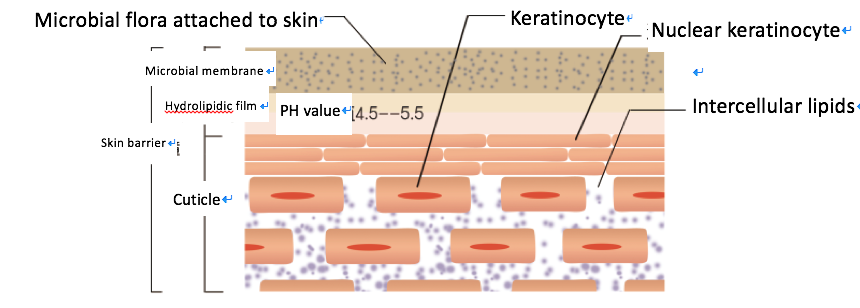
Skin Microbes – an Important Part of the Skin Barrier
Probiotics, the concept of which originates from Greek, means “for life”. In short, probiotics are often called “friendly bacteria” because they play a role in good health by supplementing an appropriate amount of them. There are 10 trillion bacteria in a human body, weighing approx. 1.5 kg. The bacteria include both harmful and beneficial ones. The beneficial ones, also known as probiotics, are friendly bacteria that are good for your health. They enhance and maintain the natural balance of micro-ecology, which is a very important balance for general health and immune system as well. The beneficial bacteria or fungi in human and animal bodies are mainly: bifidobacteria, lactic acid bacteria, Clostridium butyricum, Lactobacillus acidophilus, saccharomycete, etc.
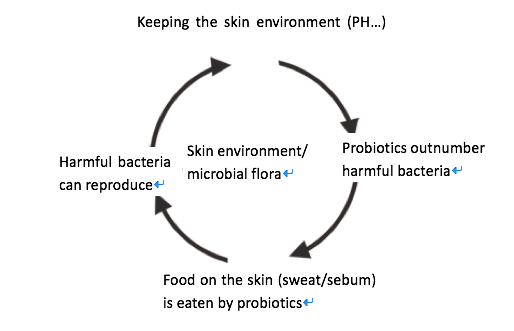
Skin Micro-ecological Balance
Studies have shown that the use of microorganisms to stimulate the development of the Th1 immune system and supplement probiotics can effectively stimulate immune cells to produce interferon, IL-10 and other cytokines, improve sensitive constitution and immunity. Probiotic therapy is a safe and effective method for the treatment of eczema. Probiotics can significantly promote the development and maturation of the immune system as well as the injury recovery, change sensitive constitution, gradually reduce the frequency and degree of allergic attacks until they disappear, fundamentally regulate the sensitive constitution, enhance immunity, and thoroughly treat allergic diseases. Nanoemulsion is a new type of safe and effective immune adjuvant. Synbiotic nanoemulsion can better enhance the immune regulation and repair capacity of probiotics.
In theory, human guts, oral cavity, skin and other tissues and organs all contain bacteria. Moreover, probiotics and harmful bacteria coexist. If there are more probiotics, the proportion of harmful bacteria will be less, and vice versa. Supplementing probiotics is the safest, the most direct and effective method for detoxification and beauty. It can inhibit the growth of harmful bacteria and reduce the production of toxins. Probiotics can gradually restore the partial micro-ecological balance of skin, resist the invasion and growth of harmful bacteria, reduce skin’s absorption and deposition of pigment, make the pigmentation fade away, and solve cosmetic problems from within. It also has a positive therapeutic effect on the treatment of acne, chloasma and other skin diseases. A growing number of studies have shown that skin microbes can promote the skin barrier and natural barrier to form a perfect balance so as to maintain the skin health.
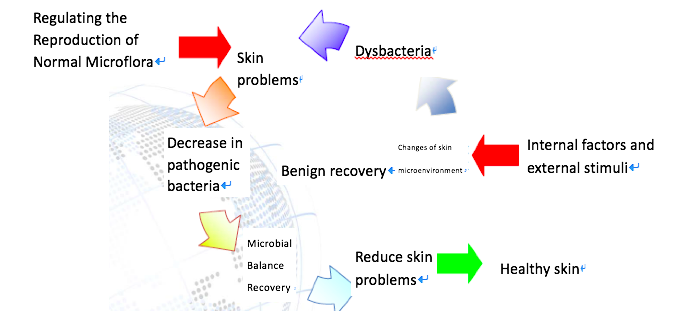
Micro-ecological adjustment to solve skin problems – handle bacteria with bacteria
Prebiotics can have a positive effect on the hosts and improve the health of hosts by selectively stimulating the growth and activity of one or several bacteria. Prebiotics only proliferate bacteria (probiotics) that are beneficial to humans, but do not proliferate harmful bacteria that have potential pathogenic or spoiling activity to humans. In general, prebiotics are the “nutrition” of human probiotics. Therefore, the addition of high-quality prebiotics to skincare products can help the skin recover and maintain a micro-ecological balance, thus ensuring normal skin barrier function.
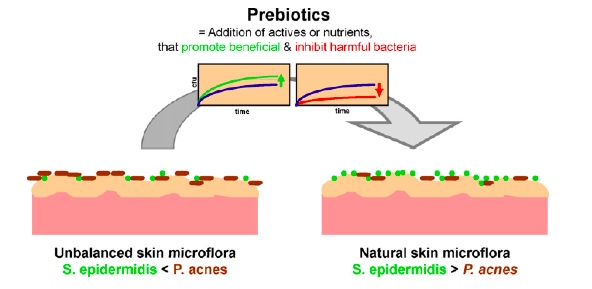

Synbiotics can promote the growth of beneficial bacteria and inhibit the growth of harmful bacteria
“Synbiotics” refers to the combination of probiotics and prebiotics. The combination of nano-encapsulated prebiotics and probiotic strains produces a synergistic effect that leads to more physiological benefits. The nano-encapsulated probiotic extract can provide nutrients and moisture for skin repair, thereby moisturizing, preventing aging and wrinkles and inhibiting pigmentation, so that the skin will return to normal. The nano-encapsulated prebiotics can effectively promote the proliferation of probiotics on the skin surface, thereby inhibiting the growth of harmful bacteria, restore the micro-ecological balance of skin as soon as possible, and keep the skin young. Synbiotics can also promote the expression of endogenous cationic antibacterial peptides (β-defensins) hBD2 and hBD3. β-defensins can directly bind to the surface of pathogens and destroy them, and prevent the invasion of certain viruses. Cellular test results showed that 0.5% BioNanoCare could promote the expression of hBD2 gene by 51%. In vitro biological tests found that 3% BioNanoCare could promote the expression of hBD3 gene by 72%.
The hair follicles and sweat glands are moist and nutritious, making them ideal for microbial enrichment. The nano-encapsulated synbiotics facilitate the entry of probiotic active matters and prebiotics, promote the growth of beneficial microbes, inhibit the growth of harmful microbes, thus maintaining the skin micro-ecological balance and a good skin barrier function.
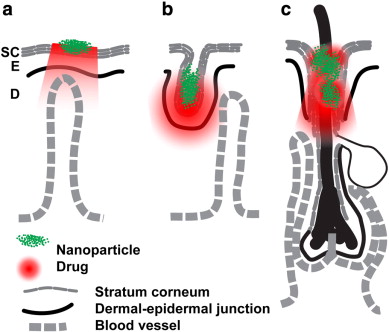
Special Hair Follicle targeting Effect of Nanoparticle Preparations
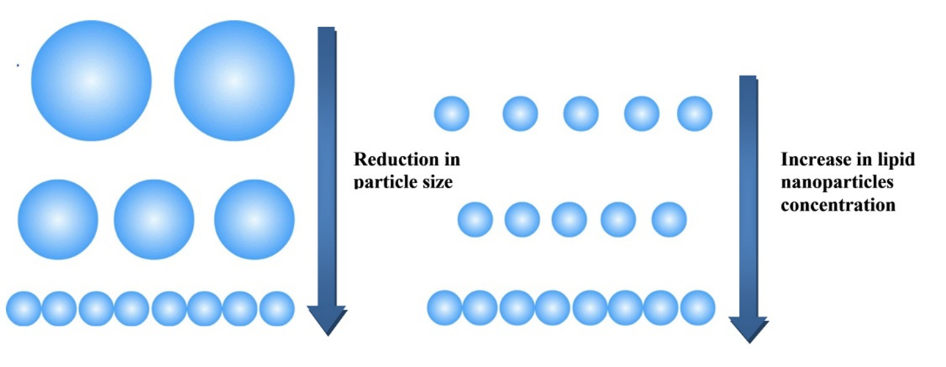
The smaller the particle size is, the stronger the adhesion effect is. Nanoparticles can form a good occlusion effect on the skin and increase the moisturizing performance of skin
Unique Closure Effect of Nanoparticle Preparations
Yeast is relatively early applied by humans, and is the most widely used microbe. People often use its fermentation to produce a variety of fermented food and wine. Meanwhile, yeast is also a multi-biological therapeutic drug, which is included in the monograph written by the German Commission E (the German statutory herbal pharmacopoeia) as an antibacterial and anti-inflammatory herb that treats acnes. In recent years, the biochemical technology has been developing continuously, especially the progress of fermentation technology. It has continuously produced high-efficiency and innovative yeast extracts. Their most prominent functions are anti-aging, deep repair, skin regeneration and anti-UV protection, anti-allergy soothing, etc. The β-glucan in the yeast wall is a key substance for yeast to exert antibacterial and anti-inflammatory effects.
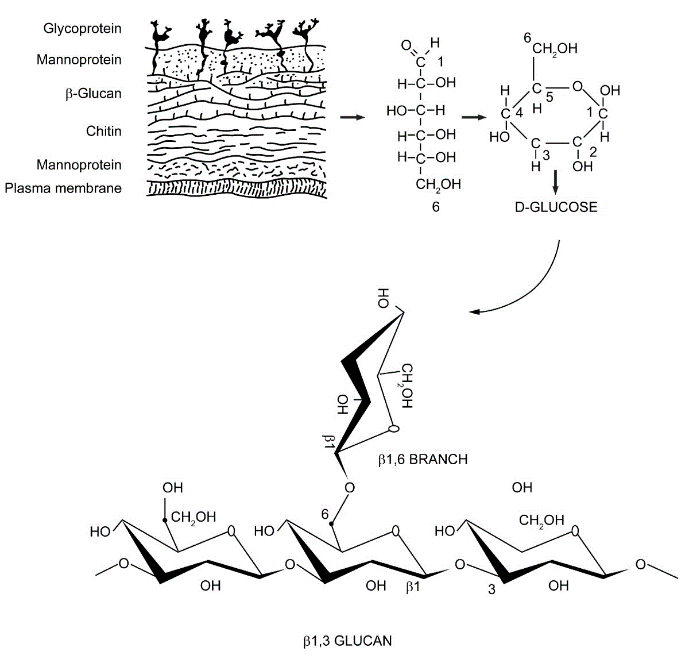
Schematic Diagram of Yeast β-glucan Structure
In the epidermis, the immune system of skin includes plasma cells, Langerhans cells, and keratinocytes. In recent years, Langerhans cells have been confirmed to have a very special relationship with macrophages in the skin, and play an extremely important role in skin immunity. There are many immune networks composed of Langerhans cells under the stratum corneum of the skin. Langerhans cells are dendritic cells, and their antennae can reach the stratum corneum cells with the receptor CR3 of yeast β-glucan. The binding of glucan to the receptor causes a series of stereo chemical changes that activate macrophages, produce various cytokines (e.g., IL-1, IL-6, GM-CSF), epidermal growth factor (EGF), tumor necrosis (TNF-α) and angiogenic factor (AF). On aging or wrinkled skin, an increase in epidermal growth factor can promote the production of collagen and elastin, thus improving the exterior of skin and eliminating small wrinkles.
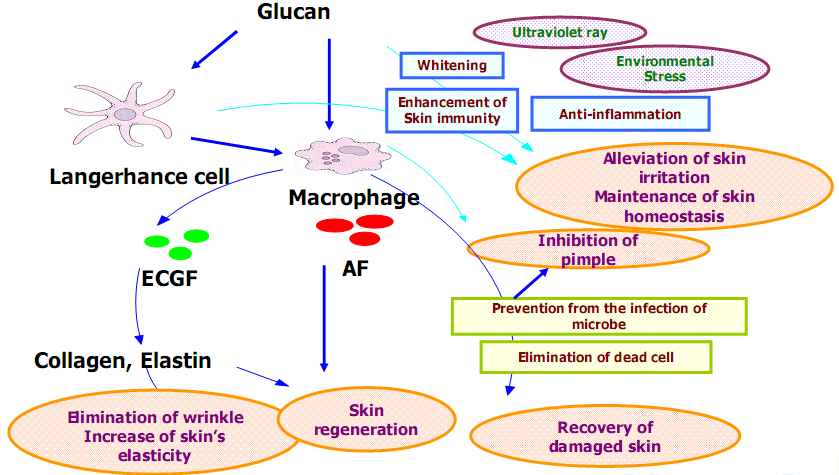
Schematic Diagram of the Biological Activity of Yeast Glucan
Studies have also shown that UV radiation has an inhibitory effect on Langerhans cells in the skin. If the skin is exposed to the sun for a long time, the number and activity of Langerhans cells will be greatly reduced, and the defense immunity of skin will be weakened. In addition to its own sunscreen effect and the ability to relieve pain and inflammation, β-glucan can also promote the proliferation of Langerhans cells and enhance skin immunity. Clinical studies have also shown that yeast glucan plays a role in anti-inflammation, anti-allergy, eliminating the activity of radicals, moisturizing and accelerating the renewal of the stratum corneum, helping the skin resist external exogenous various mechanical and chemical stimuli and promoting the recovery of injuries. Experiments have proved that yeast glucan can significantly reduce the skin allergic inflammation caused by stimulating active ingredients such as fruit acids.

Healing Effect for Couperose Skin

Healing Effect for Rashes
Application of BioNanoCare in Cosmetics
BioNanoCareis made from natural raw materials so it is non-toxic and non-irritating. It is added to skincare products to help rebuild or maintain good skin micro-ecology and skin barrier, reduce irritation, renew and repair stressed skin, effectively reduce skin wrinkles, improve skin moisture retention and smoothness, promote the recovery and regeneration of scars, brighten the skin, and treat specific dermatitis. It is widely used in anti-wrinkle and anti-aging products, sunscreen and after-sun care products, soothing products for sensitive skin and other high-end cosmetics.
Instruction for Prescription
Solubility: This product is easily soluble in water.
Recommended dosage: The product is added in an amount of 1-10%. It is recommended to add this below 50℃in the final stage of cosmetic production. It is compatible with a wide range of cosmetic ingredients.
